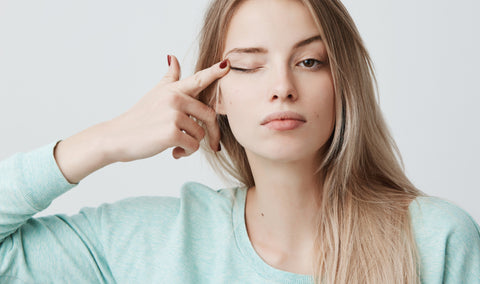Common eyelid cysts (Chalazion) and how to treat them
What is a Chalazion (eyelid cyst)?
Before we get into what a Chalazion (pronounced kuh-LAY-zee-on) is, it is important to note that there are different types of cyst that can develop on your eyelid and if you are concerned, it is always a good idea to seek advice from your GP or an eye health specialist in the first instance.
A Chalazion is the most common type of eyelid cyst, but you may be forgiven for mistaking them for another common issue which causes similar swelling, normally referred to as a ‘Stye’. Chalazion are usually recognisable as a red swelling, or defined lump inside or on the eyelid.
So what’s the difference between a Chalazion and a stye? Well, it’s that the former is not an infection, it is a blockage or build up of oils that causes a cyst on your eyelid, whereas a Stye is characterised as a type of staphylococcal infection. As such, they need treating differently.
What causes Chalazion to develop?
These cysts are caused by glands in your eyelid becoming blocked. Usually, these glands produce those all important oils to keep your eyes lubricated, but occasionally they get jammed and this will create a lump under the skin near your eye! If the oil becomes abnormally thick, it causes blockages. Because your glands cannot recognise the blockage, they continue to produce oil and this in turn means your skin begins to expand and inflate, a bit like a balloon. When this happens, you will likely start to feel a build of up pressure and/or pain.
With the swelling and pressure, you might notice that the gland slowly leaks some of the trapped oil. When this comes into contact with the surrounding skin, which we know is sensitive, it starts to act as an irritant and you’ll likely see some more inflammation. The eyelid will start to feel hot and look red.
When the cyst leaks oil, your body jumps into action, sending cells to the area to form a kind of protective capsule around the oil. At this point you may feel or even be able to see a tender lump developing under the skin of the eyelid. Over time, the swelling and the redness will decrease and a discrete lump may remain that can be felt and often seen on the eyelid.
How do I treat a Chalazion?
If you have one, you’re probably already wondering how you get rid of an eyelid cyst and how to say goodbye to the discomfort, so there are a few things you can do to ease the pain and soothe the eye. As always, it is important you are very careful and speak to a professional if your symptoms worsen or change.
You need to try and clear some of the oily build up from the lump. It is a good idea to apply some heat with an eye compress (you can do this by using The Eye Doctor and following the heating and application instructions) and gently massage the inflamed area. At this point, your body will naturally respond by moving the lump towards either the skin on the outside of the eyelid, or more commonly, inward towards the inner surface of the eyelid. If it is moved towards the outside skin, it’s likely the skin will form a ‘point’, much like a spot or boil. It will become very tender and may have a yellowish colour. Eventually, this build up will break through the skin and you’ll feel some relief as it is drained. You might be wondering by the time there’s a point, if you can squeeze your Chalazion, but the answer is no. It’s important you keep the area clean and it is advisable, with clean hands, to carefully try and work out some of the remaining oil- not by squeezing or ‘popping’ - think more gently working/milking the area.
Your body will then naturally start to heal and dissolve away the fibrous capsule that had formed, allowing your skin to mend itself over time. If you find your lump is taking time to break down and go away, you can continue to heat them, but if things persist or you feel concerned, you can seek a referral to an ophthalmologist.
The fact that you are developing these lumps suggests the oil in your glands is not able to flow freely, so recurrence is likely. You can help to reduce that risk and manage the condition by regularly heating and massaging the glands.
Don’t forget to keep an eye on any symptoms and speak to a professional if in doubt.






